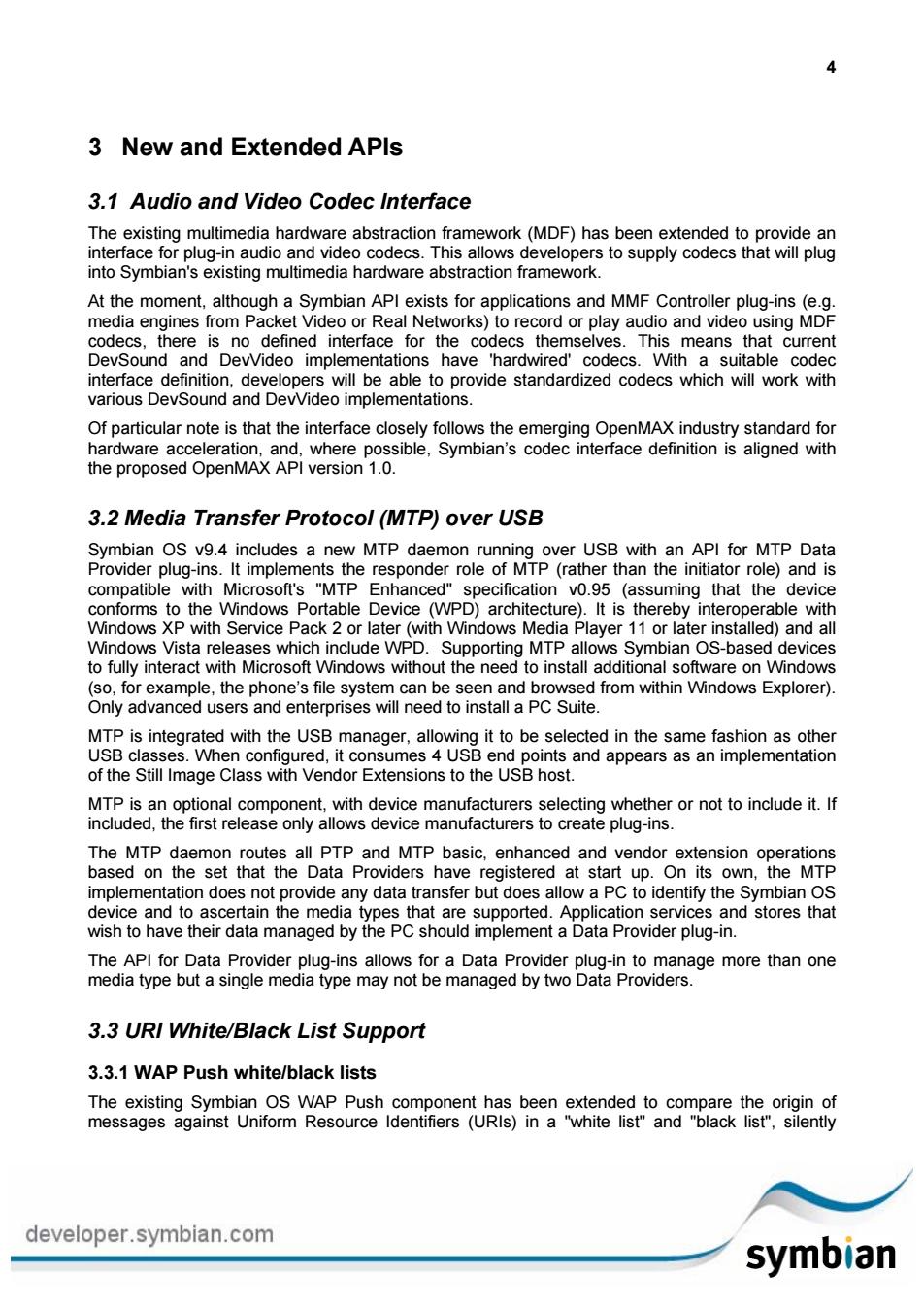正在加载图片...

3 New and Extended APIs 3.1 Audio and Video Codec Interface The existing multimedia hardware abstraction framework(MDF)has been extended to provide an e8bsiaio5nesetosupycoceshatwipu因 At the moment.although a Symbian API exists for applications and MMF Controller plug-ins(e.g media engines from Pac ket Video or Real Networks)to record or play audio and video using MDF nd a entations interface definition,developers will be able to provide standardized codecs which will work with various DevSound and DewVideo implementations. note is that the interface closel are acc h the proposed OpenMAX API version 1.0. 3.2 Media Transfer Protocol(MTP)over USB API for MTP Data compatible with Microsoft's "MTP Enhanced specification v0.95 (assuming that the device orms to the Windows Portable e Device archit cture).It is thereby interope erable with S w include WPp OS-based de to fully interact with Microsoft Windows without the need to install additional software on Windows to be selected in the same fashion as other end points and appears as an implementation of the Still Image Class with Vendor Extensions to the USB host. whether or not to include it.If and MTP basic.d vendor oRxiteonopeatons ot r a PC to identify the Svmbian OS device and to ascertain the media types that are supported.Application services and stores that wish to have their data managed by the PC should implement a Data Provider plug-in. m 3.3 URI White/Black List Support 3.3.1 WAP Push white/black lists The existina symbian os wap push component has been extended to compare the origin of messages against Uniform Resource Identifiers(URIs)in a 'white list"and"black list",silently developer.symbian.com symbian 4 3 New and Extended APIs 3.1 Audio and Video Codec Interface The existing multimedia hardware abstraction framework (MDF) has been extended to provide an interface for plug-in audio and video codecs. This allows developers to supply codecs that will plug into Symbian's existing multimedia hardware abstraction framework. At the moment, although a Symbian API exists for applications and MMF Controller plug-ins (e.g. media engines from Packet Video or Real Networks) to record or play audio and video using MDF codecs, there is no defined interface for the codecs themselves. This means that current DevSound and DevVideo implementations have 'hardwired' codecs. With a suitable codec interface definition, developers will be able to provide standardized codecs which will work with various DevSound and DevVideo implementations. Of particular note is that the interface closely follows the emerging OpenMAX industry standard for hardware acceleration, and, where possible, Symbian’s codec interface definition is aligned with the proposed OpenMAX API version 1.0. 3.2 Media Transfer Protocol (MTP) over USB Symbian OS v9.4 includes a new MTP daemon running over USB with an API for MTP Data Provider plug-ins. It implements the responder role of MTP (rather than the initiator role) and is compatible with Microsoft's "MTP Enhanced" specification v0.95 (assuming that the device conforms to the Windows Portable Device (WPD) architecture). It is thereby interoperable with Windows XP with Service Pack 2 or later (with Windows Media Player 11 or later installed) and all Windows Vista releases which include WPD. Supporting MTP allows Symbian OS-based devices to fully interact with Microsoft Windows without the need to install additional software on Windows (so, for example, the phone’s file system can be seen and browsed from within Windows Explorer). Only advanced users and enterprises will need to install a PC Suite. MTP is integrated with the USB manager, allowing it to be selected in the same fashion as other USB classes. When configured, it consumes 4 USB end points and appears as an implementation of the Still Image Class with Vendor Extensions to the USB host. MTP is an optional component, with device manufacturers selecting whether or not to include it. If included, the first release only allows device manufacturers to create plug-ins. The MTP daemon routes all PTP and MTP basic, enhanced and vendor extension operations based on the set that the Data Providers have registered at start up. On its own, the MTP implementation does not provide any data transfer but does allow a PC to identify the Symbian OS device and to ascertain the media types that are supported. Application services and stores that wish to have their data managed by the PC should implement a Data Provider plug-in. The API for Data Provider plug-ins allows for a Data Provider plug-in to manage more than one media type but a single media type may not be managed by two Data Providers. 3.3 URI White/Black List Support 3.3.1 WAP Push white/black lists The existing Symbian OS WAP Push component has been extended to compare the origin of messages against Uniform Resource Identifiers (URIs) in a "white list" and "black list", silently